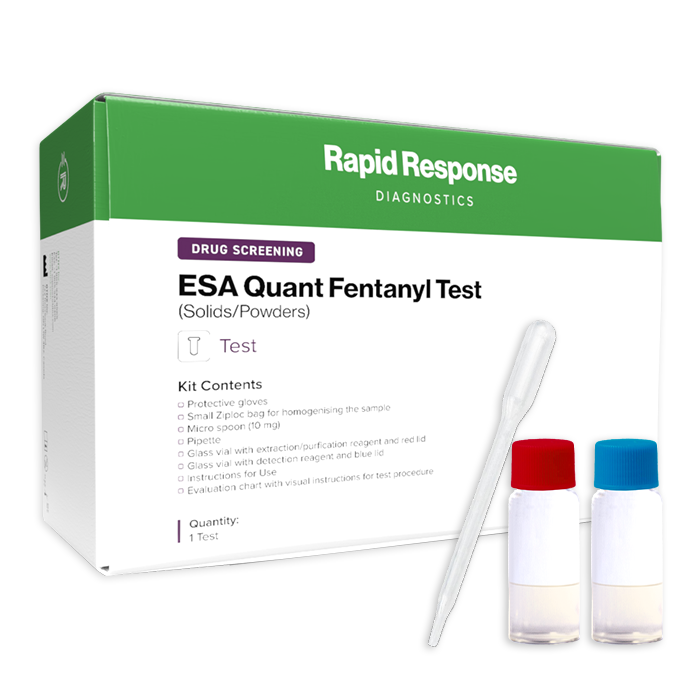

The ESA Quant Fentanyl Test enables the presumptive identification and quantification of fentanyl and some of its derivates in a drug sample.
Our ESA tests, which stand for "Eisenach Substance Analytics," allow for the rapid and straightforward identification of suspicious substances like pills, powders, dusts, and liquids through wet chemical reactions. A noticeable color change during the test indicates the specific drug present.
- Protective gloves
- Small ziploc bag for homogenising the sample
- Micro spoon (10 mg)
- Pipette
- Glass vial with extraction/purification reagent and red lid
- Glass vial with detection reagent and blue lid
- Instructions for use
- Evaluation chart with visual instructions for test procedure
The ESA Quant Fentanyl Test enables the presumptive identification and quantification of fentanyl and some of its derivates in a drug sample.
Our ESA tests, which stand for "Eisenach Substance Analytics," allow for the rapid and straightforward identification of suspicious substances like pills, powders, dusts, and liquids through wet chemical reactions. A noticeable color change during the test indicates the specific drug present.
- Remove all test kit components and check that all the materials are present described under “Materials Supplied” in the Instructions for Use. Put on the protective gloves enclosed and wear appropriate protective clothing and goggles. Please use the small Ziplock bag if the sample needs to be homogenised.
- Dispense a level micro spoon (10 mg) of the powdered substances into the vial with the extraction/purification reagent (red lid), close it tightly with the corresponding lid and shake it gently several times.
- Open the extraction vial again and remove a liquid sample using the pipette. To do this pinch the pipette bulb and hold it firmly. Then dip the tip into the liquid and carefully release the pipette bulb. The pipette will now fill with liquid.
- Release the first two drops from the pipette back into the extraction vial. Then add 3 drops (50 µL) from the pipette to the vial with the detection reagent (blue lid). The pipette should be held as vertically as possible during the dropping process. If the liquid from the pipette is not sufficient, repeat the previous procedure. Residual liquid from the pipette can be returned into the extraction vial, which should then be closed tightly.
Close the detection vial with the corresponding lid tightly, shake it gently and allow it to incubate for 30 minutes on a working bench or for 10 minutes exposed to UV light. - The reagent starts to change color in the presence of fentanyl analogues and needs 10 minutes until the color formation is noticeable. A better color change will be visible after 30 to 60 minutes in daylight or after 10 minutes exposed to UV light. The results should be evaluated with the evaluation chart after the given time.
Please refer to the instructions for use for more details.
- The color change will begin after 10 minutes and will be completely formed after 30-60 minutes. Alternatively, the evaluation can take place after 10 minutes of exposed UV light.
- By comparing the intensity of the discoloration with the evaluation chart, an evaluation can be made with the naked eye. In the presence of fentanyl in the sample to be analysed, a color change to greenish/blue will occur.
Please refer to the instructions for use for more details.
- S. H. John, A. A. Wist, A. R. Najam, J Forensic Sci, 1979, 24, 631-649
- M. D. Osselton, B. Widdop, A. C. Moffat, "Clarke’s Analysis of Drugs and Poisons”, Pharmaceutical Press, 2011 (4th Ed.)
- U.S. Department of Justice, “Color Test Reagents/Kits for Preliminary Identification of Drugs of Abuse”, 2000
- Please note that certain products may only be available in specific regions; kindly consult with a sales representative for further information regarding product availability.
- The information provided on this website is for educational purposes only and should not be construed as medical advice. Always consult with a qualified healthcare professional regarding any medical concerns or conditions.
- Our products are intended for use as specified in the product documentation. It is important to carefully read and follow all instructions provided with the product.
